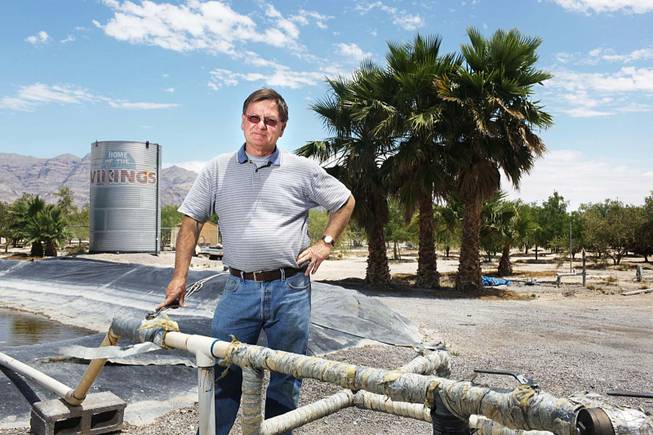
Dale Devitt, professor of soil and water science at UNLV, is the director of the Center for Urban Water Conservation in Las Vegas. He catalogs water use of different trees, shrubs and turfs.
Tuesday, June 30, 2009 | 2 a.m.
Dale Devitt is, as the joke goes, out standing in his field.
This particular field (Devitt has several) is riddled with buried experiments in the form of tubes of soil, some with grass on top, some without. This is a sort of demonstration farm and outdoor laboratory on the far north side of town.
Devitt, who runs UNLV’s Center for Urban Water Conservation, is trying to determine whether turf can filter pharmaceuticals out of reclaimed water (read: processed sewage), trapping it before it can enter the ground water.
(The answer, so far, appears to be yes, but Devitt cautions that the experiment still has two years to run.)
Devitt can look around and point to past projects. There’s a stand of trees, for instance — desert willows, mesquites, oaks and so on — most of the popular landscaping choices around Las Vegas. This was one of the first experiments Devitt ran out here. It compares the water usage of tree species. Mesquites, for instance, use more water than oaks, which use more water than willows. It sounds simple enough, comparing trees not only with one another but also with turf and shrubs, but it was groundbreaking work for a simple reason: The money has always been in agricultural research — not landscaping.
This is why, when Devitt was in school at the University of California, Riverside, getting his undergraduate degree, his master’s degree and eventually his Ph.D. in soil science, he studied the uses of waste water in agricultural irrigation. But then the day came when “they finally said, ‘Dale, we have no more degrees to offer you. You have to leave.’ ”
And the job that was available was in Las Vegas, where there was no wheat or sorghum. So he switched to urban landscaping, which had been largely ignored by researchers.
It was an ideal situation.
Devitt entered a clear field. Being out by yourself might be a little lonely, but in science it means it’s easy to do fundamental and important work. Want to know how much water a mature oak tree uses compared with Bermuda grass? You can’t look it up, so you plant some. Then, when the next guy wants to find out, he has to look up your work.
Think of it like being a test pilot. If you want to set a record today, you’ll have to train for years and years and persuade a company to spend billions of dollars developing a prototype to send you hurtling toward the mesosphere. Wilbur and Orville just had to go skipping across Kitty Hawk’s sands.
When Devitt started at the center in 1993, it was so remote from the city that he could come to work in the morning and see coyotes trotting through, back to their dens. And of course, Devitt’s field of turf grass attracted lots of jackrabbits (still does, in fact). And with the jackrabbits came extra visitors. Many mornings, Devitt would find a pile of beer cans near the road and a field full of gunshot bunnies, “enough to fill a wheelbarrow.”
Although Devitt misses the coyotes, on balance he says he’s quite happy that North Las Vegas’ civilizing suburbs have expanded to the center’s doorstep.
There’s less bunny blood on his field.

Join the Discussion:
Check this out for a full explanation of our conversion to the LiveFyre commenting system and instructions on how to sign up for an account.
Full comments policy